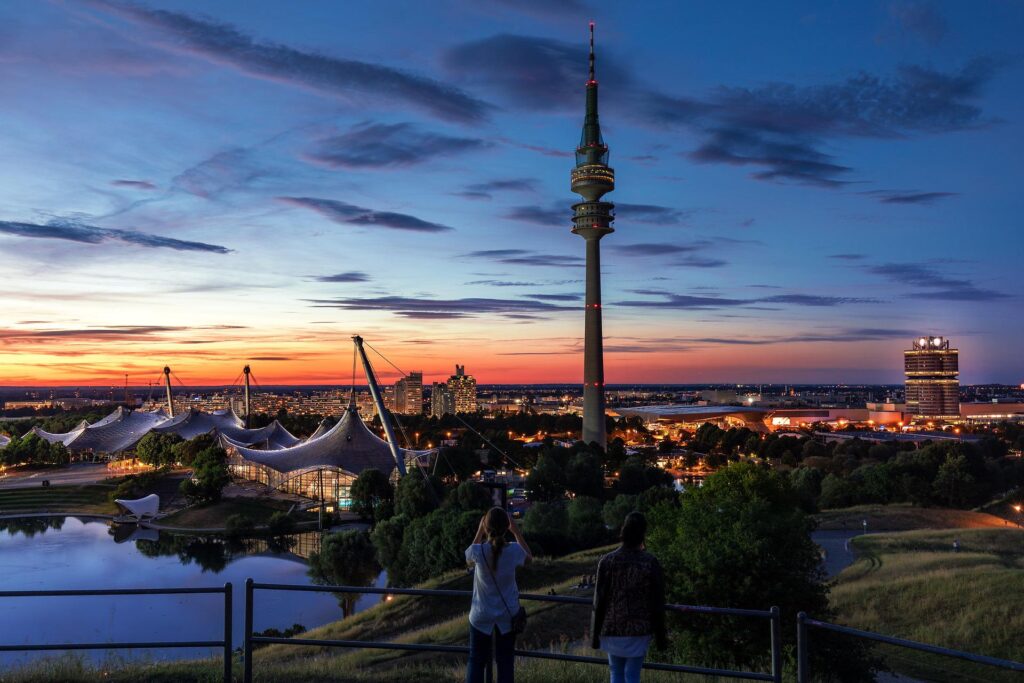The Olympic Games are routinely criticized for the huge one-time cost involved. But in Munich, they permanently shaped the city for the better. It helped the city live up to its claim of being an international city. Today, it is unimaginable without the infrastructure projects brought about by the Games.
It all began one day in the 1960s. Hans-Jochen Vogel, the mayor of Munich and proud owner of one of the most German names of all time, received a visitor with what sounded to him like a crazy idea. It was Willi Daume, President of the German National Olympic Committee, who proposed holding the Olympics in Munich. He even had the perfect venue in mind: a former airbase in the north of the city that would provide sufficient space for everything required: athlete lodging, an arena and stadiums. This central location would also ensure that the facilities would continue to be used in the future.
If you’ve ever followed the “i” information sign, then you’ve seen a product of the Munich 1972 Olympics. Its designer, a man with the ultimate Bavarian name of Otl Eicher, crafted not only the posters for these Games, he also developed the icons still in use today for swimming, athletics, archery, etc. He didn’t stop at sports, either, but also masterminded the icons for taxis, passport control and many other things. Fifty years later, these have become the international standard from Nepal to Nevada. You can verify this by flying Lufthansa – he designed their logo, too.


There was also romantic intrigue at the Games. In a previous era, royalty took great pains to pair their offspring with a suitable blueblood companion to maintain the royal brand, as it were. This networking aimed to keep power in the family and prevent conflict but often failed, most notably in the extended family quarrel known as WWI. So many of the European heads of state at that time were related that Great Britain’s Queen Victoria was nicknamed “The Grandmother of Europe.” The King of England and the last czar of Russia were said to have looked like brothers.
But modern monarchs get to choose their spouses, something that crown prince Carl Gustaf of Sweden took to heart. While visiting the Munich Olympics, he fell in love with the interpreter Sylvia Sommerlath. She became Queen Silvia of Sweden, guaranteeing her a place in both German hearts and tabloids for decades to come. Any chance of forgetting what Queen Silvia or her offspring are wearing, thinking or doing is quickly dashed by a few minutes in the waiting room at the local hairdresser’s.

The former airbase was transformed into an entirely new area of the city. The Olympic Park includes the Olympic Stadium, Olympic Hall and the Olympic Tower, which in the meantime is one of Munich’s best-known landmarks. The Olympic Village now serves as student housing. Built to house Olympic athletes, these apartments are located just a few kilometers from many major universities.
Munich touts itself as the Weltstadt mit Herz, a world metropolis with a heart, but it sure was late in jumping on the urban transport bandwagon. The London Underground began running trains way back in 1863, as did the the Ferrocarril de Sarrià a Barcelona; the Paris Métro began chugging along in 1900 and New York’s first underground trains began rumbling in 1904. Up north, Germany’s urbane Prussian sister, Berlin, built its system in 1902.
Bavarians are nothing if not conservative, but by 1972 even they were ready to build an urban train network.
What tourists know today as the heart of Munich did not exist in this form prior to 1972: the pedestrian zone. So heavy was the traffic in this area that there is even an expression “Da geht’s zu wie am Stachus,” meaning “It’s as busy as Stachus,” the name of the plaza at the west end of the pedestrian zone. This is the Bavarian version of “It’s like Grand Central Station.”
The merchants lining the Neuhauser and Kaufinger streets that were closed to traffic to create this pedestrian zone at first protested emphatically, certain that their businesses were doomed. They couldn’t have been more mistaken. This 1.3 km cobblestone stretch is now some of the city’s most valuable real estate. During the year, the pedestrian zone is packed with shoppers and during the Oktoberfest it fills up with Dirndl and Lederhosen-clad visitors en route to the fairgrounds. In December, it turns into a giant outdoor Christmas market.

It’s hard to imagine that there were ever cars and streetcars driving down what is now basically a giant sidewalk.
Finally, one of Munich’s most famous landmarks was created for the Games: the Olympic Tower. It provides the best view of the city you can get and on a clear day, you can even see the Alps, an integral part of Munich’s identity. If you live in Munich you can enjoy the Olympic Tower up close right now by taking a class with the Munich Volkshochschule. They are holding several classes right inside the tower. If taking hatha yoga inside the Olympic Tower doesn’t take you to new ethereal heights, I’m not sure what would.
But you’d better visit it before Christmas. Beginning in 2023 the tower will be closed for renovation.
Brenda Arnold
